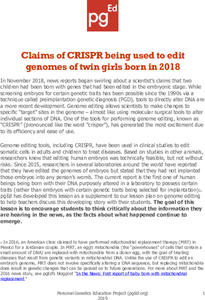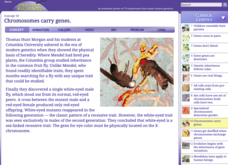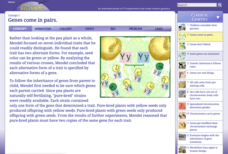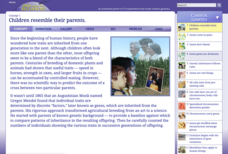California Academy of Science
Color Vision Genetics Evolution Simulation
At one point, all mammals carried only two color receptors, but now most humans carry three. An informative presentation and hands-on activity demonstrate how this evolved through genetics. By participating in the activity, pupils...
Towson University
Mystery Disease
How did scientists determine the cause of illness before technology? Science scholars play the role of medical researcher in an engaging guided inquiry activity. Using observations, technical reading, and Punnett squares, learners...
Towson University
Mystery of the Crooked Cell
Can your class solve the Mystery of the Crooked Cell? Junior geneticists collaborate to learn about sickle cell anemia in a fascinating lesson plan. The included materials help them to examine the genetic factors behind the disease...
Biology Junction
Mendelian Genetics
Over the course of seven years, Gregor Mendel grew more than 28,000 pea plants. The large amount of data he collected led him to postulate the rules of genetics as we understand them today. Scholars learn about Mendel, genetics, and...
K20 LEARN
You're My 'Karyo'-Type: Karyotype For Chromosomal Disorders
What's your type? Genetically speaking, of course! Immerse your class in the world of karyotypes through an insightful activity from the K20 Center. Scholars take on the role of genetic counselors to determine the karyotype of offspring...
Beyond Benign
Crossing Hairs
Can you breed the perfect cat? Scholars study how to control genetic traits through breeding. The 15th lesson in a 18-part genetics unit considers the process of cross-breeding to develop a cat with a specific set of predetermined traits.
Beyond Benign
Kitten Creation
Your pupils become geneticists as they create cat offspring. The next lesson in a series continues an exploration of genetic makeup as scholars consider parent traits to build their offspring. Using household items, they create kittens...
Beyond Benign
Lucky Brand Genes: Genetic Traits
Explore single-gene traits in humans. After viewing a video introducing genetic vocabulary, individuals identify their phenotype and possible genotypes of specific traits. They consider both dominant and recessive traits. This is the...
Beyond Benign
Real Cats Wear Pink
Does your cat sneak up on you in the middle of the night? Maybe it would help if he glowed in the dark like Mr. Green Genes, the first fluorescent cat in America. In a fun and engaging lesson about genetic engineering, high school...
Personal Genetics Education Project
Claims of CRISPR Being Used to Edit Genomes of Twin Girls Born in 2018
Here is an activity that blends genetic technology, literacy skills, and critical thinking. Pupils review background information about cell lines and CRISPR by video and teacher-led discussion. Scholars collaborate to analyze two...
American Museum of Natural History
All About Horses
Horses come in all shapes and sizes, but all belong to the same species. Young scholars explore the different traits and connect the information to genetic modification. The interactive gives them the option to read about 18 different...
American Museum of Natural History
What's the Big Idea About Genetics?
Here's a quick read on genetics. An engaging online resource provides six slides of information about genetics. Learners read about the meaning of genetics to information about DNA. They also learn about the study of genes and the...
American Museum of Natural History
What Do You Know About Genetics?
Just what do you know about genetics? The online resource contains 10 questions about genetics. Scholars work through the questions ranging from what DNA stands for to how much of human DNA is similar to that of a fruit fly. Scholars...
American Museum of Natural History
A Nature and Nurture Walk in Mendel Park
We are what we make of ourselves ... sometimes. Learners play a game to come up with the answer to a riddle. The game consists of determining whether different scenarios are due to nature or nature and nurture. With each correct answer,...
Alabama Wildlife Federation
Adapt-A-Bird
Not every animal has the best features for its environment. Learners study the characteristics of birds and the implications of these characteristics as related to their environments. They use what they learn to create their own new...
Science Friday
Colorful Chromosomes
Everything is in the genes. Individuals observe 14 different traits of themselves. Using pipe cleaners and beads, the learners create models of a chromosome representing their traits. The class then compares and contrasts everyone's...
Discovery Education
Blueprint for Life
DNA is the code for all biological traits, both plant and animal. Using an exploratory lesson, learners begin to explore the concept of a biological code by decoding word puzzles. They then extract DNA from plant cells using detergent to...
Agriculture in the Classroom
Roll of the Genes
Animal reproduction in sheep and cattle is explored with the help of Punnet squares. Scholars employ tools using probability to conclude the color of wool a sheep's offspring will have. Acting as animal geneticists, pupils then take...
Cold Spring Harbor Laboratory
Chromosomes Carry Genes
Some traits only exist in males and some only in females. Pupils learn how the location of genes on sex chromosomes determines them using an interactive lesson. An animation illustrates how scientists know this to be true and shows how...
Cold Spring Harbor Laboratory
Genetic Inheritance Follows Rules
Rules are not meant to be broken in genetics. Scholars learn to build Punnett squares to track the inheritance of dominant and recessive traits in an interactive animation activity. Online questions help individuals reflect on their...
Cold Spring Harbor Laboratory
Some Genes Are Dominant
Dominate a lesson on genetic traits. Young scholars learn about the difference between dominant and recessive traits with an interactive lesson. An animation demonstrates Mendel's work on the inheritance of traits, and interactive...
Cold Spring Harbor Laboratory
Genes Don't Blend
Yellow and blue make green—unless you're studying the inheritance of genetic traits. An interactive lesson explains the difference between blended traits and pure traits and gives examples of their occurrence. The resource includes a...
Cold Spring Harbor Laboratory
Genes Come in Pairs
Mendel was the first to look at individual traits within a species. Step in his shoes as an interactive lesson takes users through his journey. An animation describes the design of his experiments and how he isolated individual traits to...
Cold Spring Harbor Laboratory
Children Resemble Their Parents
Gregor Mendel's work revolutionized agriculture from an art to a science. Explore Mendel's work with an interactive lesson that includes animations, video, and practice problems. The instruction describes the early discoveries that...

























